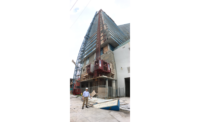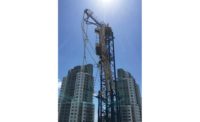With crews at work dismantling two Hurricane Irma-damaged cranes in the city of Miami and a third in Fort Lauderdale, Fla., local leaders are wondering whether Florida’s crane regulations are adequate for the highly vulnerable region.
There were 24 tower cranes up in Miami when the storm came through on Sept. 10: two that suffered partial collapses are on residential towers. At the GranParaiso tower, the crane jib fell onto the site, while a massive counterweight plummeted into the street.
In a statement after the collapse, lead contractor Plaza Construction said, “Crane engineers and the crane supplier took measures to secure the crane. The crane’s boom was nevertheless damaged due to high winds.” The dangling jib was an issue for the city, which initially refused to lift an evacuation order for two nearby buildings. Plaza Construction on Sept. 18 confirmed to ENR that the jib was secured and the order lifted.
John Moriarty & Associates is the lead contractor on Vice, a 31-story tower where another crane partially collapsed. Like the GranParaiso, damage appeared to be limited to the construction site.
The Fort Lauderdale crane was on the site of the Auberge Beach Residences & Spa. Lead contractor Moss Construction told ENR that the crane is contained within the site, and, as of Sept. 14, “there is no damage to the tower structure and power has been restored.” Moss now is working with the crane engineers to develop a removal plan.
In all three cases, it appears that the tower segments of the cranes were largely undamaged, with failures occurring above the crane towers. This may speed restoration of the cranes, as intact tower sections could be reused, according to Patrick Tarrant, CEO of New York City-based crane-rigging specialist Crane Management. “An engineering analysis will take three to four days, then they’ll mobilize a plan, and it will take a week to 10 days to remove the damaged pieces,” he told ENR. “You could then rebuild the crane on the existing tower if it is structurally sound.”
As the cleanup continues, the focus shifts to what might have been done to prevent the collapses. Preparing a tower crane for high winds varies by the make and model, but if a crane has 360° of access, the swing brake usually is released and the crane allowed to “weathervane,” spinning freely on its turntable to align with the wind. While this can reduce the chance of collapse during high winds, no crane is designed for hurricanes, according to Mike Parnell, technical director at Industrial Training International, which provides equipment and technical and education services. “There’s no crane out there today that comes with a full explanation of what happens in those sort of conditions,” he says.
Miami-Dade County has faced this issue before. A 2008 crane-safety ordinance would have required cranes to meet the ASTM B30.3 standard for crane safety, in addition to OSHA regulations and manufacturer instructions. The ordinance was struck down by a district court after a challenge by construction-industry groups, but Miami officials have said they are considering new options after Irma.
“This has been a big source of anxiety for people downtown,” says Ken Russell, Miami city commissioner for District 2, which includes the sites of the crane collapses. “We were fortunate [the cranes] came down on the buildings that were being constructed and did not strike any of the surrounding buildings, and no one was hurt. But, for sure, we as a city are going to look into legislation, regulations and practices in the future about how these cranes are handled during a storm.”
Related Article: Hurricanes Propel Forward Thinking on Risk, Resilience








Post a comment to this article
Report Abusive Comment